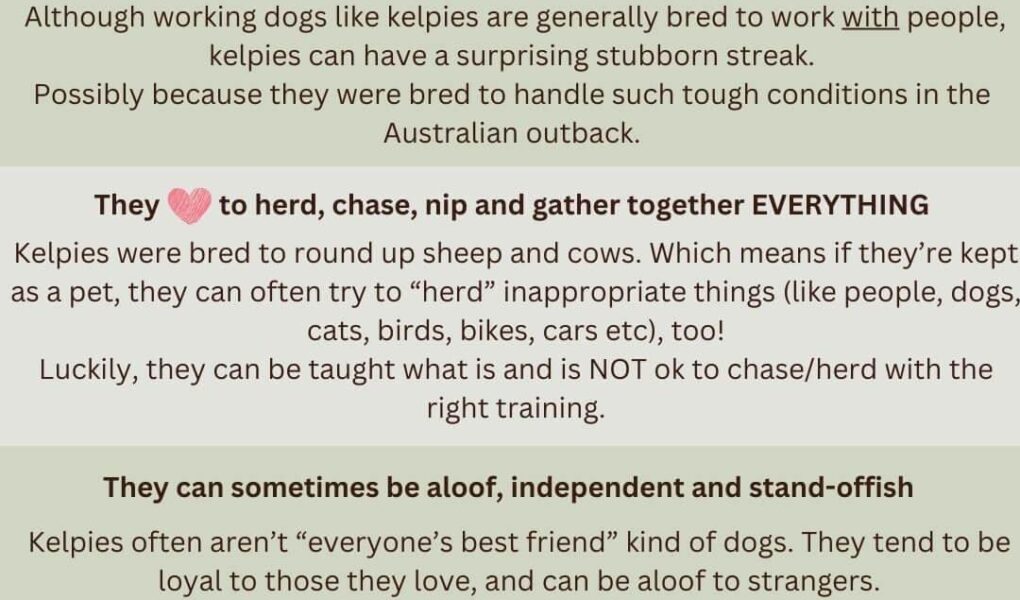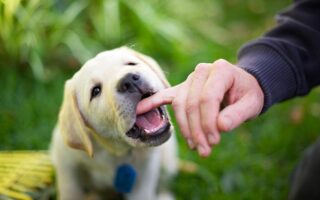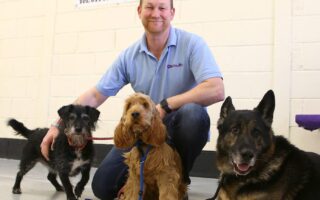Unlocking the Secrets of Kelpie Training: A Guide to Mastering Your Canine Companion
In the sun-kissed fields of Australia, where the horizon stretches endlessly and the air is filled with the earthy scent of earth and grass, the Kelpie reigns supreme as a quintessential herding dog. With their agile bodies and sharp minds, these dogs are not just bred for work, but for companionship, loyalty, and boundless energy. Training a Kelpie can be both a joyful adventure and a challenging endeavor, as their intelligence often outpaces their ability to settle. In this article, we will delve into the art and science of Kelpie training, exploring techniques, tips, and insights that will help you harness the full potential of your furry friend. Whether you’re a seasoned dog trainer or a first-time Kelpie owner, join us as we embark on a journey to strengthen the bond between you and your Kelpie, transforming natural instincts into harmonious teamwork.
Table of Contents
- Essentials of Understanding the Kelpie Temperament
- Effective Techniques for Positive Reinforcement Training
- Socialization Strategies to Cultivate a Well-Rounded Companion
- Addressing Common Behavioral Challenges in Kelpies
- Q&A
- In Conclusion
Essentials of Understanding the Kelpie Temperament
To effectively train a Kelpie, recognizing their unique temperament is crucial. These dogs are known for their high energy and intelligence, which requires a structured approach to training. Kelpies thrive in environments that challenge their mental and physical abilities, making it essential to incorporate activities that stimulate both. Some traits that define Kelpie temperament include:
- Eagerness to learn - Kelpies are intelligent and quick learners, making them responsive to training.
- Work ethic – Their natural herding instincts mean they excel when given purposeful tasks.
- Sensitivity - Kelpies may react to harsh training methods; positive reinforcement proves more effective.
- Social needs – They enjoy interacting with people and other dogs, enhancing their training experience.
To further demonstrate how their characteristics can shape training protocols, consider the following table that outlines effective training strategies tailored for Kelpies:
| Characteristic | Training Strategy |
|---|---|
| High Energy | Incorporate physical exercises such as agility or fetch into training sessions. |
| Intelligence | Use puzzle toys and obedience challenges that require problem-solving. |
| Playfulness | Keep sessions light-hearted with games that reinforce commands. |
| Herding Instinct | Utilize herding exercises to leverage their natural instincts in a controlled environment. |
Effective Techniques for Positive Reinforcement Training
To effectively train your kelpie using positive reinforcement, it’s essential to create a reward system that resonates with your dog’s preferences. Kelpies are highly driven and responsive to various motivators. Some effective rewards include:
- Treats: Use small, tasty treats that your kelpie loves. Keep them handy during training sessions.
- Verbal Praise: Use an encouraging tone of voice, accompanying your words with enthusiasm for a job well done.
- Playtime: Incorporate play as a reward, whether it’s with a favorite toy or a game of fetch.
Additionally, timing is crucial in positive reinforcement training. Ensure that rewards are given immediately after the desired behavior occurs. This clarity helps your kelpie understand the connection between the action and the reward. You may find it beneficial to track your dog’s progress in a simple table, which can help you identify patterns and preferences:
| Behavior | Reward Used | Response |
|---|---|---|
| Sit | Treat | Quickly responds |
| Stay | Verbal Praise | Maintains position |
| Come | Playtime | Excitedly runs back |
Socialization Strategies to Cultivate a Well-Rounded Companion
To foster a well-rounded companion, incorporating diverse socialization experiences is essential during your kelpie’s early development stages. Begin by introducing your puppy to a variety of environments, sounds, and people. Public parks, busy streets, and pet-friendly events serve as excellent venues to expose your kelpie to new stimuli. This approach not only builds confidence but also enhances the dog’s adaptability. Additionally, consider setting up playdates with other dogs of different breeds, as this will help your kelpie learn essential communication cues and social skills.
Structured training classes can also play a pivotal role in socialization. Obedience classes, agility training, and canine sports offer opportunities for your kelpie to interact with both humans and peers in a controlled setting. Below is a simple overview of effective socialization activities:
| Activity | Benefits |
|---|---|
| Visit Dog Parks | Encourages social play and interaction |
| Introduce Different Environments | Builds adaptability and confidence |
| Group Training Classes | Enhances obedience and social skills |
| Frequent Outings | Familiarizes with urban distractions |
Balance is key; while it is important for your kelpie to interact with other dogs, ensure that these exposures are positive. Monitor your dog’s reactions and provide reassurance when facing new experiences. Always aim to create enjoyable experiences for your kelpie, reinforcing good behavior with treats and praise. Following these strategies will set the foundation for a social, confident, and well-behaved companion.
Addressing Common Behavioral Challenges in Kelpies
Kelpies are known for their high energy and intelligence, making them wonderful companions and workers. However, these traits can lead to specific behavioral challenges if not properly managed. To address issues such as excessive barking, jumping, or herding behavior, it is crucial to establish a consistent training routine. Here are some practical strategies to help you navigate these challenges:
- Positive Reinforcement: Reward your kelpie with treats and praise when they exhibit desirable behaviors to encourage repetition.
- Structured Exercise: Provide daily physical and mental stimulation through activities like fetch, agility training, or puzzle toys to tire them out.
- Clear Boundaries: Set and enforce rules consistently to help your kelpie understand what is acceptable behavior.
- Socialization: Expose your dog to various environments, people, and animals early on to reduce reactive behaviors.
When dealing with more profound behavioral issues, patience and persistence are key. Consider creating a training schedule that includes regular sessions focused on specific challenges. Use a simple tracking table to monitor progress that might look like this:
| Behavior Issue | Training Method | Progress (1-5) |
|---|---|---|
| Barking at strangers | Desensitization | 3 |
| Jumping on guests | Reinforced sits | 4 |
| Chasing livestock | Controlled exposure | 2 |
This structured approach allows you to identify patterns and adjust your training as needed, making it easier to achieve your goals. With dedication and the right techniques, you can help your kelpie become a well-behaved member of your family.
Q&A
Q&A: Everything You Need to Know About Kelpie Training
Q: What is a Kelpie, and what makes their training unique?
A: The Australian Kelpie is a highly energetic and intelligent herding dog, famous for their agility and stamina. Their strong work ethic and eagerness to please set them apart, making training both rewarding and necessary. Kelpies thrive on mental stimulation and physical activity, so any training program should consider these traits to be effective.
Q: At what age should I start training my Kelpie?
A: Ideally, you can begin training your Kelpie as early as eight weeks old. Starting with basic commands and socialization during this formative period is crucial. Early training helps establish good behaviors and strengthens the bond between you and your pup, laying a solid foundation for more complex tasks later on.
Q: What training techniques work best for Kelpies?
A: Positive reinforcement techniques, such as treats and praise, are particularly effective for Kelpies. They respond well to motivation and encouragement, so incorporating playtime and rewards into training sessions keeps their spirits high. Consistency is key, as is incorporating plenty of variety to prevent boredom—consider agility courses or herding trials to keep them engaged!
Q: How important is socialization in Kelpie training?
A: Extremely important! Socialization helps Kelpies become well-rounded dogs. Exposing them to various environments, people, and other animals can prevent behavioral problems in the future. Aim for diverse experiences during the first year, and continue introducing them to new situations throughout their lives to keep their confidence high.
Q: Can I train my Kelpie for specific tasks, like herding or agility?
A: Absolutely! Kelpies are versatile and excel in various dog sports, including agility, obedience, and, of course, herding. If you’re interested in task-specific training, seek out clubs or classes that focus on those disciplines. Professional trainers can provide valuable guidance and techniques tailored to your Kelpie’s unique abilities.
Q: How long should a training session be for my Kelpie?
A: Kelpies have high energy levels but can easily become distracted or fatigued. Aim for 10 to 15-minute training sessions, gradually increasing the duration as your dog becomes more focused. It’s essential to finish on a positive note, leaving your Kelpie eager for the next session.
Q: My Kelpie has some behaviors that concern me. How do I address them?
A: Common behaviors like jumping, barking, or excessive herding instincts can be mitigated with consistent training and redirection. Identify the triggers for these behaviors and work on training techniques that focus on desirable alternatives. Patience and a firm, yet gentle approach are crucial. Consulting a professional trainer can provide additional support and tailored strategies.
Q: What’s the most important thing to remember when training a Kelpie?
A: Enjoy the process! Training should be a fun and rewarding experience for both you and your Kelpie. Celebrate small victories, stay patient through the learning curve, and always remember that a happy dog is an obedient dog. Building a strong bond through training will ensure your Kelpie not only learns commands but becomes a loyal companion for life.
In Conclusion
As you embark on the rewarding journey of kelpie training, remember that every moment spent with your canine companion is an opportunity for growth and bonding. These intelligent and spirited dogs thrive on mental and physical stimulation, making the training process not just a necessity, but a delightful experience. With patience, consistency, and a touch of creativity, you can harness their boundless energy and sharp minds to foster a deeper connection while teaching them valuable skills. Whether you’re refining their herding abilities or simply guiding them through basic commands, your efforts will undoubtedly pay off in the form of a well-behaved, happy kelpie. So, lace up your shoes, grab those treats, and step into the vibrant world of kelpie training—because together, you and your furry partner are destined to create something truly special.


